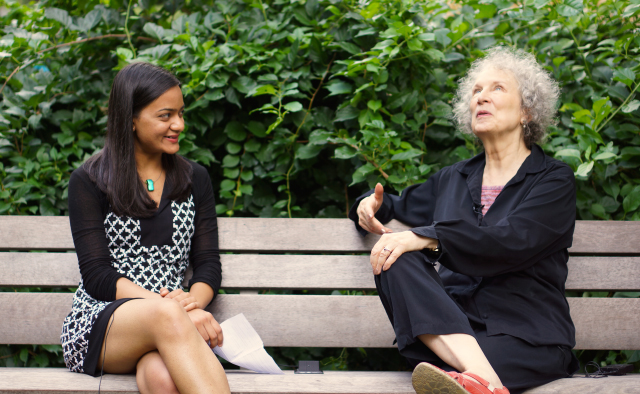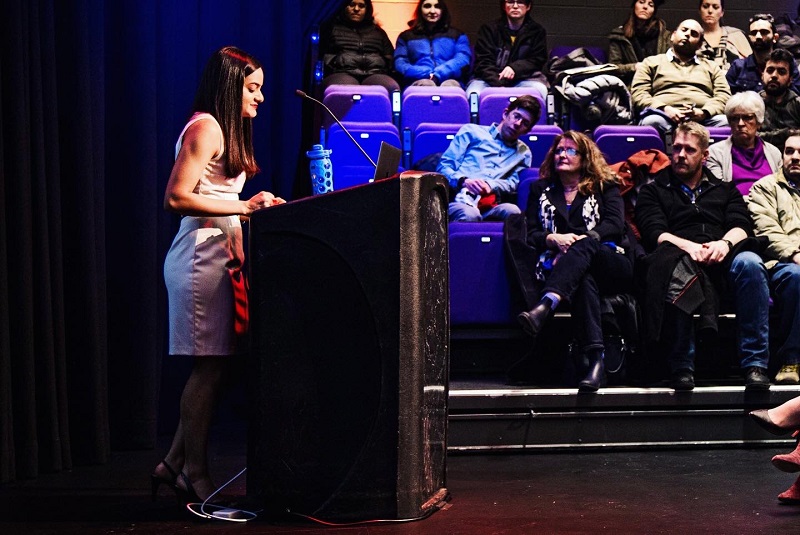(June 16, 2022) When she travelled to the Arctic in 2013, Canadian student and researcher Maya Burhanpurkar was, understandably, blown away by the incredible beauty of the glacial landscapes that surrounded her. There was, however, a sense of foreboding – the massive glaciers that typically flow to the ocean and become icebergs were grounding out before her eyes. “It struck me that the icebergs we were seeing could be some of the last anyone would ever see. And that it could happen alarmingly soon,” she says. She pulled out her camera and filmed everything she could, interacting with the local Inuit community, who live in harmony with their surroundings but are the first to bear the brunt of the climate crisis. That’s how her documentary film, 400 PPM, came to be – with appearances by Canadian author Margaret Atwood, astronaut Chris Hadfield and the famed explorer Wade Davis. The title was a nod to historic levels of greenhouses gases in the atmosphere, noted by a Hawaiian observatory in 2015-16. “It was a wakeup call, we didn’t think we could go beyond 400 parts per million but of course, these days, we do so regularly,” Maya says in an interview with Global Indian. This year, having graduated summa cum laude from Harvard, Maya will head to Oxford University as a Rhodes Scholar in the fall.
Now 23, Maya already has a glowing record in scientific research already under her belt. Apart from making an acclaimed documentary, she is a two-time winner of the Canada-Wide Science Fair and has done cutting edge research at Harvard University, the University of Toronto as well as at the Dominion Radio Astrophysical Observatory, where she worked with the CHIME experiment.

Maya Burhanpurkar with author Margaret Atwood, for the making of 400 PPM
Never too young
Maya’s interest in science began as early as five or six years of age. Born to engineer parents, with grandparents who were medical professionals, an interest in scientific thought was alive at home, and Maya’s curiosity was always encouraged. At 10, she built a microbiology lab in her basement in Canada to experiment on the effects of turmeric and neem on harmful pathogens. “My mother and grandmother had always told me that the herbs and spices we use in Indian food do more than just make it taste good, they have certain healing properties. At the time, Western Science hadn’t caught on to this at all,” she tells Global Indian.
Brimming with curiosity, Maya wanted to test the hypothesis. But in 2010, things like petri dishes weren’t available to the public. After “cold emailing university professors” and getting no response, she received help from a high school science teacher. She created an incubator for the bacteria using an electric heating blanket which she placed inside a soda cooler. Her takeaway was twofold: First, turmeric “was incredibly effective at killing the bacteria.” Second, “it was a lesson in resourcefulness and perseverance.”
Forays into theoretical physics
At 13, she taught herself calculus. “I was just starting high school then and had heard a lot about Calculus.” Differential calculus is typically taught at the twelfth-grade level in Canada but “those were the early days of the Khan Academy.”. “They had posted videos and I taught myself, as a ninth grader. The relationship between Mathematics and Physics was of special interest to me. I really enjoyed Physics – it teaches you how to model the whole world. And it all involves Calculus.”
In her early teens, she began her journey into theoretical physics, asking “the kind of questions that only a super naive kid would ask,” as she puts it, very modestly. “What happens if you keep taking more derivatives of acceleration? What happens with more integrals of distance?” At the University of Toronto, she worked to build a device that could measure the integrals of distance. “We were the first to build something like that, as far as I know,” Maya says. As much as she enjoyed her foray into theoretical physics, her concern for humanity’s problems led her down a more applied path.


The Rhodes Scholar delivers a talk on AI for the Barrie Public Library
The Canada-Wide Science Fair
As she watched her grandfather’s condition deteriorate from Alzheimer’s, a distraught young Maya wondered what she could do to help. She tested two drugs that are commonly used in the early stages of Alzheimer’s treatment on daphnia, a common species of water flea often used in experiments. “He was taking a lot of other drugs as well and I wanted to see how the cocktail was affecting his heart,” she explains. “I noticed the drugs regularised heart rate, whether it was high or low. I never followed it up in a more rigorous setting but it certainly was fascinating.” The experiment got her top place at the Canada-wide Science Fair, an event she took pains to attend every year –”It was one week of the year where I could be around people my age who were also interested in science,” she says. “It was incredible to have won there, twice.”
The CHIME experiment, superconductors and cosmology
Rather unsurprisingly, Harvard University welcomed Maya. She deferred acceptance for a year, however, to work instead at the Perimeter Institute for Theoretical Physics in Waterloo, where she did research for CHIME, a novel radio telescope that has no moving parts, originally meant to detect fast radio bursts. “I had a truly amazing mentor and I went back during my first summer break in college as well,” says Maya. She worked on algorithms for blind pulsar searches, to detect pulsars that are orders of magnitude fainter than normal.
Starship PI: boldly going where no physicists have gone before @Perimeter pic.twitter.com/PbgzGPhyyk
— Maya Burhanpurkar (@MBurhanpurkar) July 21, 2018
She also worked with Subir Sachdev, a world-renowned condensed matter theorist, working on machine learning techniques that could efficiently determine whether or not a potential material is a superconductor, or if it has other exotic properties of interest. “Typically, it takes years to come up with a mathematical solution but we can run a simulation and determine very quickly if the material is interesting.” Her interest in machine learning also came in later at Harvard, as she worked with Professor Cynthia Dwork, a theoretical cosmologist at the university’s Physics Department. “We wanted to create an algorithm for eliminating algorithmic bias,” she says.
On ethics and economics: The Rhodes Scholarship
A chance economics class at Harvard, taught by Nobel-Prize winning economist Amartya Sen, opened Maya’s eyes to a whole new world. It was an abstract class but she was taken by the “approach of economists in terms of thinking about the world.” “It piqued my interest and led me to a master’s in economics.” It ties in well with her own work on the climate crisis. “What are economic implications of climate policy? How do we initiate the clean energy transition and do it in a way that’s equitable for everyone in the world? There’s so much work to be done and I love to learn,” she smiles. The Rhodes Scholar also toyed with the idea of a programme in the philosophy of physics at Oxford University before settling on a master’s in Economics instead.
Maya also did a stint with an early-stage VC fund, an experience she thoroughly enjoyed. It gave her the opportunity, she says, to think critically and to “think differently from people more senior to me in the organisation.” Venture capital tends to function within conventional patterns, something Maya would like to see change. “For instance, there haven’t been a lot of women in top roles in the US historically. I think private venture capital can play a role in that, in not reinforcing existing biases.”
As co-founder of Adventus Robotics, she is also working on developing a self-driving wheelchair, which doesn’t use a conventional joystick interface that is inaccessible to those with arthritis or age-related tremors. “There is a lot of work in terms of cutting-edge sensors and computation, but the thing with cutting edge is that it’s expensive,” she says. “If we want to help the average person, we need off-the-shelf, low-cost sensors and the ability to combine those with cutting edge algorithms,” she says. It’s a project she began before Harvard and continues to work on. “We’re working with leading hospitals, airports and airlines to roll it out,” she says. For this, she was the winner of the 2020 Harvard i3 Innovation Challenge and the Lemelson-MIT Student Prize.
What lies ahead
Reflecting on her journey so far, she says she hasn’t followed a certain path. “A lot of it was about me being in a particular place at a particular time,” she says. “Each experience has enabled me to make a contribution. But the one thing that has always persisted through my life is my curiosity. I have always been curious, I want to learn new things, I love talking to people and asking them questions. Everyone has something interesting to say, everyone is an expert at something and I love the game of finding out.” It’s the idea of what she calls thoughtful leadership that truly compels her. “Regardless of what I specifically end up doing, I hope to be in a position where I can provide that,” she says.



